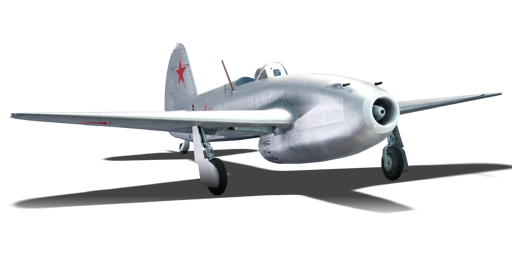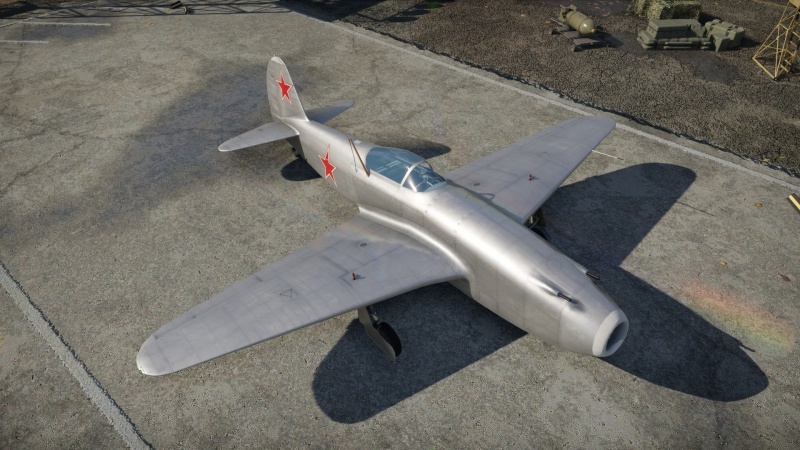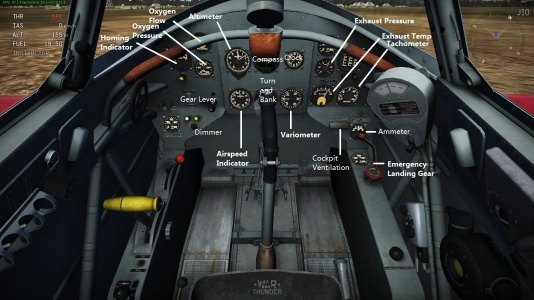Yak-15
| This page is about the Soviet jet fighter Yak-15. For the later version, see Yak-15P. |
Contents
Description
The Yak-15 was one of the first attempts by the Soviet Union to produce a jet-engined fighter. Development started at the end of WWII, and to reduce development time, it was decided to use the existing airframe of the Yak-3 piston fighter and adapt a reverse-engineered German Junkers Jumo 004 engine. It was developed alongside the MiG-9 and it's still disputed to this day which of the two was the true first jet fighter of the USSR. Compared to its aforementioned competitor, the Yak-15 was easier to fly thanks to being designed on the basis of the Yak-3, many pilots already knowing how to fly the plane. A total of 280 units were built until 1947, and it was specially used to adapt old piston fighter pilots to fly jet-engined fighters.
It was introduced in Update 1.31. The Yak-15 suffers from the poor engine in early jets. This, and the fact that it usually fights late prop fighters with very powerful piston engines, makes this jet hard to master for noob pilots. However, it still has the airframe of the Yak-3. This makes the Yak-15 a very nimble and agile fighter capable of pulling extreme manoeuvres and very tight turns. The most important obstacles to overcome are the low ammo pool (60 rounds per gun) and the very weak engine with just 850 kgf when stock. To survive, it is important to climb and stay outside of fights without allied help. In 1v1 situations, the jet engine in the Yak-15 will make it lose less energy in turns compared to piston fighters; however, regaining lost speed back is harder and takes more time, so having altitude that can easily be converted to energy is important
General info
Flight performance
The handling of the Yak-15P is uncomfortable in most situations. For a jet engine, it has very poor top speed and the acceleration at all states can be considered inferior. With a poor climb rate and weak engine is easy to set yourself in hard situations. However the Yak-15 has a very nimble airframe and good agility in dogfights, and its weak engine is enough to make him hold speed better than most props in a turn fight.
| Characteristics | Max Speed (km/h at 4,000 m) |
Max altitude (metres) |
Turn time (seconds) |
Rate of climb (metres/second) |
Take-off run (metres) | |||
|---|---|---|---|---|---|---|---|---|
| AB | RB | AB | RB | AB | RB | |||
| Stock | 719 | 699 | 19.1 | 20.1 | 19.7 | 19.2 | 366 | |
| Upgraded | 792 | 755 | 18.3 | 18.5 | 26.5 | 23.0 | ||
Details
| Features | |||||
|---|---|---|---|---|---|
| Combat flaps | Take-off flaps | Landing flaps | Air brakes | Arrestor gear | Drogue chute |
| X | X | ✓ | X | X | X |
| Limits | ||||||
|---|---|---|---|---|---|---|
| Wings (km/h) | Gear (km/h) | Flaps (km/h) | Max Static G | |||
| Combat | Take-off | Landing | + | - | ||
| 750 | N/A | N/A | 320 | ~12 | ~9 | |
| Optimal velocities (km/h) | |||
|---|---|---|---|
| Ailerons | Rudder | Elevators | Radiator |
| < 380 | < 420 | < 500 | N/A |
Engine performance
| Engine | Aircraft mass | ||||||
|---|---|---|---|---|---|---|---|
| Engine name | Number | Basic mass | Wing loading (full fuel) | ||||
| Klimov RD-10 | 1 | 2,120 kg | 183 kg/m2 | ||||
| Engine characteristics | Mass with fuel (no weapons load) | Max Gross Weight | |||||
| Weight (each) | Type | 9m fuel | 20m fuel | 30m fuel | 32m fuel | ||
| 760 kg | Axial-flow turbojet | 2,296 kg | 2,484 kg | 2,667 kg | 2,708 kg | 2,719 kg | |
| Maximum engine thrust @ 0 m (RB/SB) | Thrust to weight ratio @ 0 m (100%) | ||||||
| Condition | 100% | WEP | 9m fuel | 20m fuel | 30m fuel | 32m fuel | MGW |
| Stationary | 910 kgf | N/A | 0.40 | 0.37 | 0.34 | 0.34 | 0.34 |
| Optimal | 910 kgf (0 km/h) |
N/A | 0.40 | 0.37 | 0.34 | 0.34 | 0.34 |
Survivability and armour
- 8.5 mm Armour plating behind pilot
Modifications and economy
Obtaining the "Offensive 23 mm" modification is the best choice as it allows for more flexibility in armament. Next, try to obtain the "Compressor" and "Engine" upgrades as they both increase engine thrust which is essential in escaping from a dogfight turned sour. Finally, obtain the rest of the performance upgrades as they will all collectively increase top speed, turn time, and rate of climb.
Armaments
Offensive armament
The Yak-15 is armed with:
- 2 x 23 mm NS-23 cannons, nose-mounted (60 rpg = 120 total)
Usage in battles
In Realistic battles, climbing with this aircraft at the start of a match is not always the best course of action, considering how poor the Yak-15's rate of climb is. Instead of the traditional, slow angled climb the Yak-15 is best used in a "zoom climb" where once enough energy has been built up at a low altitude the Yak-15 pilot will pitch up, thus gaining a lot of altitude quickly. This way, if attacked during the first few minutes of the match, the Yak-15 still wields some energy whereas had the Yak-15 been slowly climbing, it would have had to face another aircraft's guns. In order to shake an enemy, especially a prop driven enemy, dive low to the ground to ensure your assailant's speed only decreases. This is called a "speed trap" and can either be followed by a "hammerhead" attack or a continuation of the escape. This tactic of utilizing the Yak-15's ability to hold on to energy in a straight line is negated when facing other jet aircraft who wield the same ability. This is where the Yak-15's dog fighting abilities come into play. Because it is so similar to the Yak-3, the Yak-15 retains some of its maneuverability characteristics, namely its turn time. This facet often proves an indispensable one as other first generation jets will not be able to maintain a tight enough turn circle. This allows the Yak-15 to outperform even the best-turning first-generation jets such as the Ho 299 and the Vampire(s), as long as you have an energy advantage.
Additionally, vertical maneuvers should be used in favor of horizontal maneuvers, especially when not actively engaging with an enemy. For example, if turning to approach an enemy, it is best to use a 180° vertical loop rather than a horizontal 180° turn, as this allows you to convert the potential energy gained from your height increase into horizontal speed as you dive. This is a key skill in flying the Yak-15 as speed losses from horizontal maneuvers take a long time to recover, and should be employed whenever needing to adjust for a horizontal deviation of 30° or greater. Additionally, pilots should refrain from making high-G maneuvers outside of combat, and should keep all control inputs smooth.
One tactic that you can employ is to "zoom climb" to 1500m, and then gain as much speed as possible (600km/h+ is best) and wait for another plane to attempt a head on attack. From there, at 1.2km away, start to make yourself a mildly harder target, and at 600m, start to commence a half-loop. Doing this will grant you the ability to get on your opponent's tail, and the already commenced turn for better turn times. If your opponent is foolish enough to commence a dogfight, then carefully use your 23mm to hit them once you're around 400m away and on their tail. This will work against all planes of all nations, including the Spitfire F Mk 24 and Japanese fighters alike. If the opponent is smart enough to continue flying away, leave them to regain some altitude and speed, and attempt again. If the maneuver is also done incorrectly and your opponent manages to get their sights on you first, then try to outrun them, using your fantastic straight line energy retention and altitude.
However, the Yak-15 is severely hampered in its damage output due to its reliance on a single set of 23 mm NS-23 cannons, with 120 shells total. It is possible to expend this pool in seconds. The Yak-15 shares this downfall with aircraft like the Ki-200, and the Me-163. Firing in small, accurate bursts negates this and is the most efficient way of destroying enemies. The 23 mm shells these cannons fire are extremely deadly when they hit and often rip enemies apart.
To use the guns most effectively, be close to your target. The reason for this is twofold: First, the limited ammo means you want your shots to count. Being close to your target will give your cannons the highest chance of hitting. The second reason is because of the ballistics of the 23 mm shells - their muzzle velocity is not very high, meaning you have to lead your targets by quite a bit. If you are closer to your target, you won't have to lead them by quite as much, although still more than most other cannons.
With some practice, it is possible to consistently get about 3 fighter kills with one load of ammunition in Realistic battles. Using the Air Targets belt is the most effective. However, attacking bombers is best left to other planes with more firepower, since the Yak-15 does not have the firepower or ammunition to reliably kill heavy bombers without sustaining heavy damage. Heavy fighters such as the F7F-1 may also take longer to destroy than other fighters.
In Arcade battles, the Yak-15 is capable of breaking up a "furball" due to its impressive turn time. This coupled with its hard-hitting cannons makes any Yak-15 pilot an indispensable asset to any Arcade team.
Enemies of note:
Kikka - These are significantly faster than you, and climb better. Since they control the engagement, you cannot do much unless they decide to dogfight with you.
A2D-1 - These turboprops are some of the most common opponents you will see. You vastly outmaneuver them, but they can full surprisingly sharp turns and have extremely powerful armament.
F-84G-21-RE - Found in several nations, these fighters are extremely fast, well armed, and durable. Similar to the Kikka, it can control engagements with you so unless they make a mistake, they will be untouchable, as well as being able to take a few hits from your cannons.
SK60B - Being slower than you, you can generally control the engagement. However, they are one of the few planes that can maneuver with you, so it will require a fair amount of dogfighting knowledge in order to shoot down, and mistakes will be punished-one hit from the 30 mm ADENs will result in critical damage.
Pros and cons
Pros:
- Excellent turn time for a jet fighter (can outturn F8Fs at some moments)
- Good armament (when the shells hit)
- Fairly good roll rate
- Fairly responsive at higher speeds
- Small target
Cons:
- 2nd slowest jet fighter of the game
- Low ammunition count
- Mediocre rate of climb
- Poor acceleration
- Lack of armour protection
- Low rip speed
- Unable to re-start the engine below 270-330 km/h (170-205 mph)
History
| Archive of the in-game description | |
|---|---|
|
An all-metal, single-seat fighter equipped with a turbojet engine. Its development started at the end of World War II, when the Soviet Union captured numerous German components, including Junkers Jumo-004 jet engines. This engine was studied in the USSR, and the Klimov OKB created a domestic counterpart under the designation RD-10. In turn, the Yakovlev OKB used the design to produce a jet fighter based on the latest version of the well-liked Yak-3. The designers decided in favor of the pod-and-boom layout. A turbojet engine with 900 kg thrust was mounted instead of the old VK-107A piston engine. The engine was inclined so that the jet stream exited underneath the fuselage and wing. The rest of the airframe was left almost unchanged, except for an additional heat shield, made of refractory steel, located in the exhaust section. The aircraft's armament included two Nudelman-Suranov NS-23KM cannons with 60 rounds each. The cannons were housed in the forward fuselage above the engine. The new Yakovlev fighter was originally called the Yak-Jumo but later obtained the designation Yak-15. The first flight of the Yak-15 was on April 24, 1946, and the plane was launched into full-scale production in the autumn of the same year. Production Yak-15 planes had a different engine, the RD-10, manufactured in the USSR. The service life of the earliest engines was officially claimed to be 25 hours, but in reality it was 17 hours at best. Nevertheless, the Yak-15 was very easy to pilot, and its steering was similar to that of the Yak-3, which had been the basis of its development. As a result, it was decided that although the Yak-15 did not meet the requirements of the Air Force for a modern combat fighter, it was perfectly suitable as a transition from prop to jet aircraft. In addition to its engine's limited service life, the Yak-15 had a number of distinctive disadvantages. The most commonly encountered defects during its operation included hydraulic fluid leaks (through the sealing rings of the landing gear shock struts), the rupturing of rudder control cable threads, and the deterioration of tail wheel springs (probably caused by overheating). But the Yak-15's main disadvantage was its very short flight range. Nevertheless, the significance of the Yak-15 in the history of Soviet aviation should not be underestimated. Hundreds of pilots underwent training on planes of this type, and it was the Yak-15 that became the first Soviet jet aircraft officially accepted for service in the Air Force as well as the first jet fighter that enabled military pilots to master advanced aerobatics. Production of the Yak-15 was discontinued in 1947. In all, 280 planes were constructed. | |
Media
- Skins
- Images
- Videos
See also
Links to the articles on the War Thunder Wiki that you think will be useful for the reader, for example:
- reference to the series of the aircraft;
- links to approximate analogues of other nations and research trees.
External links
| A.S. Yakovlev Design Bureau (Яковлев Опытное конструкторское бюро) | |
|---|---|
| Fighters | |
| Yak-1 | Yak-1 · Yak-1B |
| Yak-3 | Yak-3 · Eremin's Yak-3(e) · Yak-3 (VK-107) · Yak-3P · Yak-3T · Yak-3U |
| Yak-7 | Yak-7B |
| Yak-9 | Yak-9 · Yak-9B · Yak-9K · Golovachev's Yak-9M · Yak-9P · Yak-9T · Yak-9U · Yak-9UT |
| Twin-engine fighters | I-29 |
| Jet fighters | |
| Yak-15 | Yak-15P · Yak-15 |
| Yak-17 | Yak-17 |
| Yak-23 | Yak-23 |
| Yak-30 | Yak-30D |
| Yak-141 | Yak-141 |
| Strike aircraft | |
| Yak-2 | Yak-2 KABB |
| Yak-38 | Yak-38 · Yak-38M |
| Bombers | Yak-4 |
| Jet bombers | Yak-28B |
| Foreign use | ▄Yak-3 · Challe's ▄Yak-9T · ◔Yak-9P |
| Captured | ▀Yak-1B |
| USSR jet aircraft | |
|---|---|
| Bereznyak-Isayev | BI |
| Yakovlev | Yak-15 · Yak-15P · Yak-17 · Yak-23 · Yak-28B · Yak-30D · Yak-38 · Yak-38M · Yak-141 |
| Mikoyan-Gurevich | MiG-9 · MiG-9 (l) · MiG-15 · MiG-15bis · MiG-15bis ISh · MiG-17 · MiG-17AS · MiG-19PT |
| MiG-21F-13 · MiG-21PFM · MiG-21S (R-13-300) · MiG-21SMT · MiG-21bis | |
| MiG-23M · MiG-23ML · MiG-23MLD · MiG-27M · MiG-27K | |
| MiG-29 · MiG-29SMT | |
| Lavochkin | La-174 · La-15 · La-200 |
| Sukhoi | Su-9 · Su-11 |
| Su-7B · Su-7BKL · Su-7BMK · Su-17M2 · Su-17M4 · Su-22M3 | |
| Su-24M | |
| Su-25 · Su-25BM · Su-25K · Su-25T · Su-25SM3 · Su-39 | |
| Su-27 · Su-27SM | |
| Su-34 | |
| Ilyushin | IL-28 · IL-28Sh |
| Tupolev | Tu-14T |






